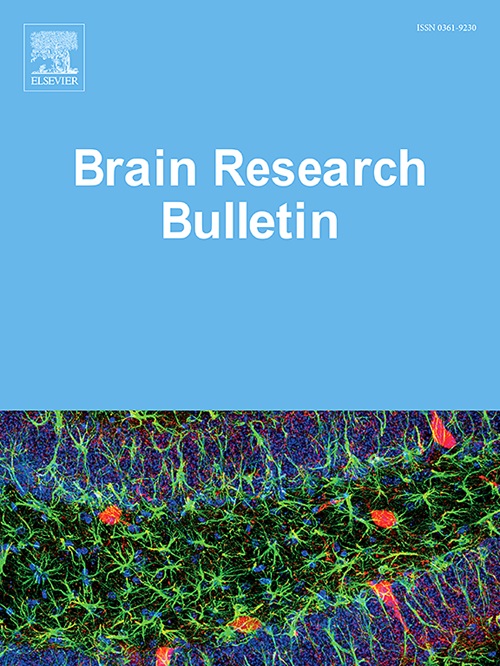Automated quantification of axonal and myelin changes in contusion, dislocation, and distraction spinal cord injuries: Insights into targeted remyelination and axonal regeneration
IF 3.5
3区 医学
Q2 NEUROSCIENCES
引用次数: 0
Abstract
Quantifying axons and myelin is essential for understanding spinal cord injury (SCI) mechanisms and developing targeted therapies. This study proposes and validates an automated method to measure axons and myelin, applied to compare contusion, dislocation, and distraction SCIs in a rat model. Spinal cords were processed and stained for neurofilament, tubulin, and myelin basic protein, with histology images segmented into dorsal, lateral, and ventral white matter regions. Custom MATLAB scripts identified axons and myelin through brightness-based object detection and shape analysis, followed by an iterative dilation process to differentiate myelinated from unmyelinated axons. Validation showed a high correlation with manual counts of total and myelinated axons, with no significant differences between methods. Application of this method revealed distinct injury-specific changes: dislocation caused the greatest axonal loss, while distraction led to the lowest myelin-to-axon-area ratio, indicating preserved axons but severe demyelination. All injuries resulted in increased axon diameter and a decreased myelin-sheath-thickness-to-axon-diameter ratio, suggesting disrupted myelination. These results indicate that remyelination therapies may be most effective for distraction injuries, where preserved axons make remyelination crucial, while axonal regeneration therapies are likely better suited for dislocation injuries with extensive axonal loss. Contusion injuries, involving both axonal and myelin damage, may benefit from a combination of neuroprotective and remyelination strategies. These findings highlight the importance of tailoring treatments to the distinct pathophysiological features of each SCI type to optimize recovery outcomes.
挫伤、脱位和牵张脊髓损伤中轴突和髓鞘变化的自动量化:针对髓鞘再生和轴突再生的见解。
量化轴突和髓磷脂对于理解脊髓损伤(SCI)机制和开发靶向治疗至关重要。本研究提出并验证了一种自动测量轴突和髓磷脂的方法,用于比较大鼠模型中的挫伤、脱位和牵张SCIs。脊髓处理并染色神经丝、微管蛋白和髓鞘碱性蛋白,组织学图像分为背侧、侧侧和腹侧白质区。定制的MATLAB脚本通过基于亮度的物体检测和形状分析来识别轴突和髓鞘,然后通过迭代扩张过程来区分有髓鞘和无髓鞘轴突。验证表明,人工计数与总髓鞘轴突和有髓鞘轴突高度相关,方法之间无显著差异。应用该方法发现了明显的损伤特异性变化:脱位引起最大的轴突损失,而牵张导致髓鞘与轴突面积比最低,表明轴突保存但脱髓鞘严重。所有损伤均导致轴突直径增加,髓鞘厚度与轴突直径之比降低,提示髓鞘形成中断。这些结果表明,髓鞘再生疗法可能对牵张损伤最有效,其中保存的轴突使髓鞘再生至关重要,而轴突再生疗法可能更适合于广泛轴突损失的脱位损伤。包括轴突和髓鞘损伤的挫伤可能受益于神经保护和髓鞘再生策略的结合。这些发现强调了针对每种SCI类型的不同病理生理特征定制治疗以优化恢复结果的重要性。
本文章由计算机程序翻译,如有差异,请以英文原文为准。
求助全文
约1分钟内获得全文
求助全文
来源期刊

Brain Research Bulletin
医学-神经科学
CiteScore
6.90
自引率
2.60%
发文量
253
审稿时长
67 days
期刊介绍:
The Brain Research Bulletin (BRB) aims to publish novel work that advances our knowledge of molecular and cellular mechanisms that underlie neural network properties associated with behavior, cognition and other brain functions during neurodevelopment and in the adult. Although clinical research is out of the Journal''s scope, the BRB also aims to publish translation research that provides insight into biological mechanisms and processes associated with neurodegeneration mechanisms, neurological diseases and neuropsychiatric disorders. The Journal is especially interested in research using novel methodologies, such as optogenetics, multielectrode array recordings and life imaging in wild-type and genetically-modified animal models, with the goal to advance our understanding of how neurons, glia and networks function in vivo.
 求助内容:
求助内容: 应助结果提醒方式:
应助结果提醒方式:


